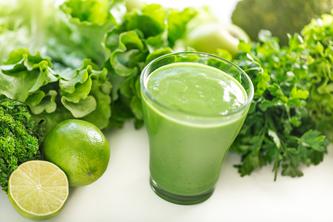Juicing
Green Juices: I’ll keep this one brief since the inter-web is awash with all the benefits of juicing. Eating green vegetables and in the form of juicing should be part of everyone’s diet, both from a preventative and restorative perspective. The juicing process does remove the fiber, which has the benefit of being easily and quickly absorbed by your body, so you’ll want to make sure you are getting enough fiber elsewhere in your diet. I supplement with pure rice bran fiber, as well as psyllium husks.
With little fiber in the juice, it is wise to minimize the fructose containing fruits which are often used to cut green juices, such as apples, peaches, and mangos. Given the rapid absorption of sugar, these can cause an insulin spike, thereby promoting fat storage, and negate the positive benefits of the greens. Lemons and limes are best to cut your juice with.
The benefits of juicing are overwhelming, but no need to go crazy and drink gallons of the stuff—everything in moderation. Coniferous vegetables such as broccoli, and raw cabbage, and kale are goitrogenic and therefore contain substances that suppress the functioning of the thyroid gland by interfering with iodine uptake. But if your thyroid is currently healthy, you’d arguably have to eat quite a boatload (40 cups of broccoli by some estimates) to materially impact you, but it is something to keep in mind especially if you do have thyroid issues.
Another downside of juicing Oxalic acid, which is contained in high concentrations of uncooked spinach, beet greens, and collard greens (a full list here). Oxalic acid blocks the absorption of calcium, iron, and other minerals and may precipitate out in crystalline form and cause kidney stones. Again, the benefits far outweigh downsides, choose the contents of your juice wisely and if you eat a healthy diet with a lot of greens already, you probably don’t need a large green juice every single day (though it worked out pretty well for Joe Cross).
Recommended juicing ingredients; most of which are moderately goitrogenic and with no or low oxalic acid content: Kale – relatively moderate goitrogenic impact, and low oxalic acid content Cucumbers – contains an anti-inflammatory flavonol called fisetin and also inhibits pro-inflammatory enzymes Beets – Great detox vegetable, though a bit high in fructose relative to greens. Carrots – too much vit A may be tough on you liver so use moderately, I have noticed increase fatigue lasting upwards of 23hrs if I drink more than 12 oz of pure carrot juice. Wheatgrass – I would be cautious here as there is some debate on the benefits of wheatgrass juice. Even proponents of the juice advice not to take it every day. Humans aren't built to digest grass, we don't have four stomachs like a cow. When a dog wants to throw up eat grass. I would avoid wheatgrass. Spinach – though definitely in moderation given its relatively modest oxalic acid content And cut with lemon or lime juice. And supposedly green apples have a lower fructose content. Or even better to cut with celery or cucumbers.
With little fiber in the juice, it is wise to minimize the fructose containing fruits which are often used to cut green juices, such as apples, peaches, and mangos. Given the rapid absorption of sugar, these can cause an insulin spike, thereby promoting fat storage, and negate the positive benefits of the greens. Lemons and limes are best to cut your juice with.
The benefits of juicing are overwhelming, but no need to go crazy and drink gallons of the stuff—everything in moderation. Coniferous vegetables such as broccoli, and raw cabbage, and kale are goitrogenic and therefore contain substances that suppress the functioning of the thyroid gland by interfering with iodine uptake. But if your thyroid is currently healthy, you’d arguably have to eat quite a boatload (40 cups of broccoli by some estimates) to materially impact you, but it is something to keep in mind especially if you do have thyroid issues.
Another downside of juicing Oxalic acid, which is contained in high concentrations of uncooked spinach, beet greens, and collard greens (a full list here). Oxalic acid blocks the absorption of calcium, iron, and other minerals and may precipitate out in crystalline form and cause kidney stones. Again, the benefits far outweigh downsides, choose the contents of your juice wisely and if you eat a healthy diet with a lot of greens already, you probably don’t need a large green juice every single day (though it worked out pretty well for Joe Cross).
Recommended juicing ingredients; most of which are moderately goitrogenic and with no or low oxalic acid content: Kale – relatively moderate goitrogenic impact, and low oxalic acid content Cucumbers – contains an anti-inflammatory flavonol called fisetin and also inhibits pro-inflammatory enzymes Beets – Great detox vegetable, though a bit high in fructose relative to greens. Carrots – too much vit A may be tough on you liver so use moderately, I have noticed increase fatigue lasting upwards of 23hrs if I drink more than 12 oz of pure carrot juice. Wheatgrass – I would be cautious here as there is some debate on the benefits of wheatgrass juice. Even proponents of the juice advice not to take it every day. Humans aren't built to digest grass, we don't have four stomachs like a cow. When a dog wants to throw up eat grass. I would avoid wheatgrass. Spinach – though definitely in moderation given its relatively modest oxalic acid content And cut with lemon or lime juice. And supposedly green apples have a lower fructose content. Or even better to cut with celery or cucumbers.

